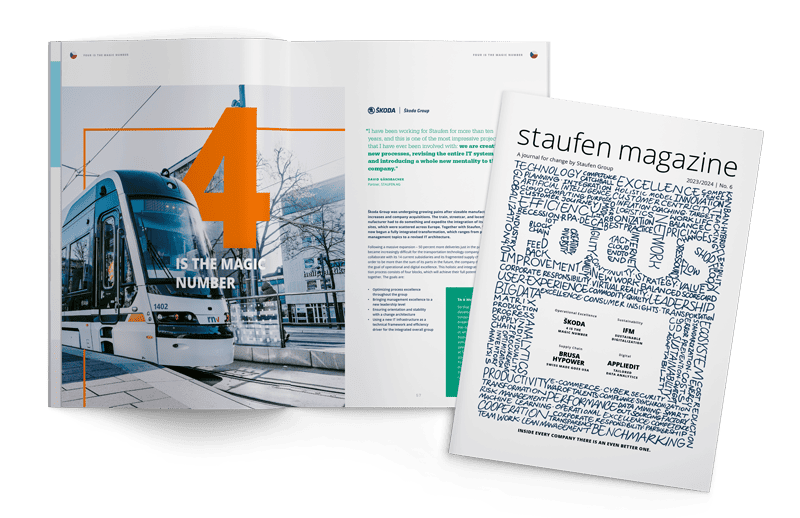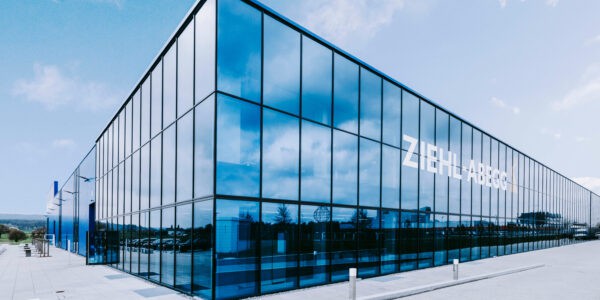
Škoda Group was undergoing growing pains after sizeable manufacturing increases and company acquisitions. The train, streetcar, and locomotive manufacturer had to do something and expedite the integration of its production sites, which were scattered across Europe. Together with Staufen AG, Škoda has now begun a fully integrated transformation, which ranges from process and management topics to a revised IT architecture.
Following a massive expansion – 50 percent more deliveries just in the past year – it became increasingly difficult for the transportation technology company Škoda Group to collaborate with its 14 current subsidiaries and its fragmented supply chain network. In order to be more than the sum of its parts in the future, the company decided to pursue the goal of operational and digital excellence. This holistic and integrated transformation process consists of four blocks, which will achieve their full potential when taken together. The goals are:
- Optimizing process excellence throughout the group
- Bringing management excellence to a new leadership level
- Ensuring orientation and stability with a change architecture
- Using a new IT infrastructure as a technical framework and efficiency driver for the integrated overall group
According to CEO Didier Pfleger, this integration course is necessary in order to optimally prepare Škoda Group for the next growth steps: “Numerous stand-alone solutions, which have become established at the individual sites over the years, represented a high risk, also in terms of technology. At the same time, we wanted to harmonize cooperation across all manufacturing sites and increase potential efficiency. For this reason, we chose a coordinated approach in which processes, management methods, and IT-systems are simultaneously modernized.” With this approach, Škoda improves procedures and becomes more efficient in all units through the introduction of lean methodology on the process and leadership side. With the digital tools of the new IT-infrastructure, the company fills the processes with life, identifies weak points, and can successfully handle the increasing order volume.
“The change in mentality is already taking place”
A company-wide transformation process of this size is not just about tools and processes, but also, and especially, the people involved. CEO Pfleger: “A new culture, revised processes, or the effects of the change architecture require a lot of persuasion. Now that we have completed about a quarter of our journey, the feedback so far has been overwhelmingly positive. The important thing is that the employees accept the new system and recognize its benefits for them. People must understand why previous ways of working are changing and how we can work as one unit across borders.”
The workforce of Škoda Group has grown from around 6,000 employees to almost 8,000, spread over many units in Europe. Due to their history, individual departments still worked in isolation in the beginning. Interrupting this kind of silo mentality requires more than changing processes and systems. That is why Didier Pfleger particularly wants to reach the people in the course of the transformation process: “In many people’s heads, we are still a Czech company. And the focus is still here, in this country. However, as a group, we are now international, and that requires employees to think differently. Naturally, there are cultural barriers, sometimes communication problems, and uncertainties. But the transformation process and the process improvements through lean management show that we are on the right path and that the change in mentality is already taking place.”
We chose Staufen, because the advisors have a pragmatic approach and don’t hold theoretical talk shows. They go into the factory halls, explain, and offer convincing solutions. For that reason, they are accepted both by the manufacturing employees and the management. This operative focus is typical for Staufen.
Didier Pfleger, CEO, ŠKODA Group
New IT-backbone for the growth strategy

Didier Pfleger
CEO
Škoda Group

Didier Pfleger
CEOŠkoda Group
Didier Pfleger has been the CEO of the Škoda Group since 2022 and has extensive management experience in the most important European markets, as well as in the USA, Asia, and Africa. Before his time with Škoda, he held management positions at Alstom, GEA, and the ABB-group. Didier Pfleger is a graduate of Ecole Polytechnique in Paris and Ecole Supérieure de l’Aéronautique in Toulouse.
https://www.skodagroup.com/
An analysis of the company-wide IT landscape showed the importance of deeper integration. The experts at Staufen AG identified more than 100 different applications for the order fulfillment process alone. This situation complicated the harmonization between the subsidiaries, which are distributed throughout Europe, and also increased the manual effort for data transfer. In addition, the multitude of different systems led to functional overlaps and redundancies, which tied up a great deal of capacity in the IT department.
CEO of Škoda Group Pfleger: “The old IT-systems were no longer keeping up with our growth. That is why we had to look for new solutions and approach the challenges of the future from two sides: first from the process side in order to improve processes and become more efficient in all units, and second from the side of digital tools.” In the future, the basic IT framework of the entire group will be formed by just four systems: a CMS by Salesforce, a PLM by Siemens, an ERP by SAP, and IBM Maximo for asset management. “With these tools, we cover around 90 percent of the organization. They form the backbone of the new system, and all processes must be oriented toward this,” Pfleger continues.
The implementation of this large digitalization project in combination with a complete lean transformation is a feat that must be carefully controlled. “We know that we are asking a lot of our employees by making such sweeping changes within a project framework of just under two years. But this simultaneous approach is rational, because the tools, services, and processes all interact with one another. This will achieve the goal faster, and the result is better than if we were to introduce the innovations over a longer period of time,” CEO of Škoda Group Pfleger is convinced.
The Company
Škoda Group products include mainly low-floor trams, electric locomotives, suburban train units, metro sets, electric buses and trolleybuses, as well as control and drive systems for transport systems. Škoda Group has several production sites in the Czech Republic and one in Finland. The group also has business units in Germany, Italy, Austria, Hungary and other countries. It employs 8,000 people in its companies. It is only thanks to high investments in research and development that Škoda Group can regularly come up with new and modern products that are successfully finding their place on foreign markets. It invested € 81.1 million in research and development in 2021.
Request the English Magazine now as a digital or print version

You might also be interested in

Wind of change
In order to be able to continue to process the constantly growing number of orders to their satisfaction, ZIEHL-ABEGG has started a lean transformation at its largest production site. Greater efficiency and leadership excellence should ensure consistent product quality and high delivery reliability at all locations in Germany and abroad.
Read more
We no longer look for who is to blame – Transdev
In order to achieve a cultural change towards continuous improvement at the headquarters of the Transdev Group, located southwest of Paris, Staufen AG first familiarized all 400 employees with the fundamentals of Lean Management through a “Lean game”. Ten people were trained as internal Lean consultants, so that in the future, they can assist their colleagues with their in-depth knowledge of Lean methods. At the same time, management training sessions were carried out with 80 executives to clarify their (key) roles in the cultural change and to develop expertise. Lean Principles formed the foundation for the orientation of the Lean Transformation.
Read more
Study: Future Industry
How the industry is positioning itself for the future! Our new study on the topics of digitalization, efficiency, sustainability and resilience.
Read more

